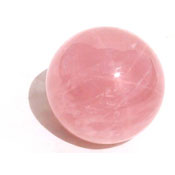Rose Quartz
(rohz kwawrts)
HISTORY and LORE
- Rose quartz beads dating back to 7000 BC have been found in the area once known as Mesopotamia (today’s Iraq). Rose quartz jewelry was known to be crafted by the Assyrians around 800-600 BC. The Assyrians, along with the Romans, might have been the first to use this stone.
- People in the earliest recorded times believed in the magical powers of quartz. Ancient Roman, Egyptian, and Greek civilizations used quartz crystals as potent talismans. The Romans used rose quartz as a seal to signify ownership, and Egyptians believed the stone could prevent aging.
- According to New Age gem therapists, rose quartz promotes love in all its positive forms, from kindness and nurturing to friendship and romance. It also helps its wearer learn forgiveness and tolerance, and opens the heart to beauty within and without.
VALUE FACTORS
- Color: Light to medium pink.
- Clarity: Usually translucent, but can be almost transparent. Frequently contains internal fractures that produce a cloudy appearance.
- Cut: Most often beads, cabochons, and carvings. Sometimes faceted.
- Size/Weight: All sizes are available. Occurs in pieces big enough for large carvings and other ornamental purposes. (Normally not priced or sold by carat weight.)
TREATMENT
Rose Quartz is occasionally irradiated to improve color. This duplicates a process that can occur naturally in the earth. The treatment’s effects are normally permanent, and it creates no special care requirements for gem owners.
GEMOLOGY
- A variety of quartz, the most abundant mineral species in the earth’s crust. Other quartz varieties include amethyst, citrine, smoky quartz, and tiger’s eye.
- Composed primarily of silicon and oxygen: chemical formula SiO2. Color caused by trace amounts of iron and titanium.
CARE
Rose quartz generally has good wearability.
- Hardness: Moderate scratch resistance. Rates 7 on the Mohs Hardness Scale.
- Toughness: Good resistance to chipping and breaking.
- Stability: Occasionally fades if exposed to intense light for a long time. Otherwise, no routine concerns for gem owners.
- Cleaning: Liquid cleaner, or detergent and water. Ultrasonic is usually safe.
